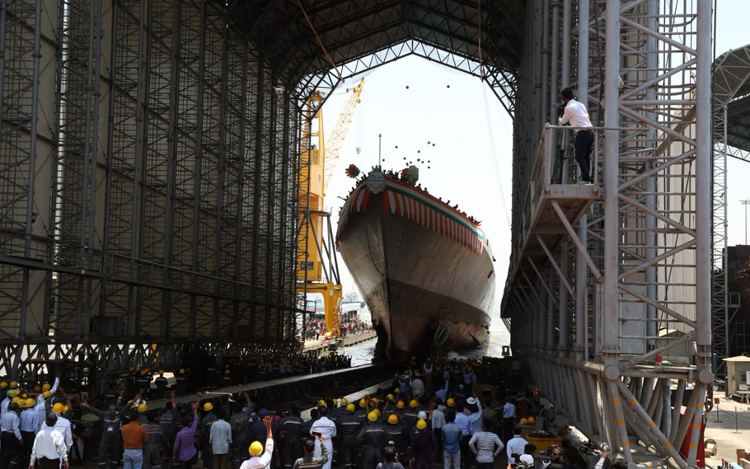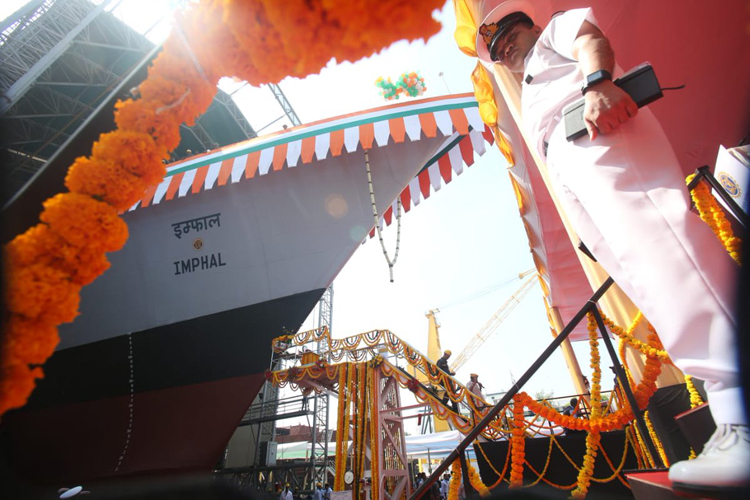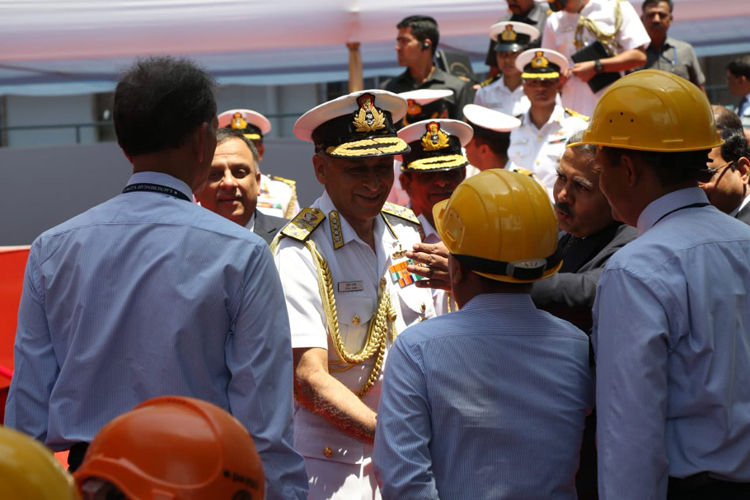INDIAN ARMED FORCES CHIEFS ON
OUR RELENTLESS AND FOCUSED PUBLISHING EFFORTS

SP Guide Publications puts forth a well compiled articulation of issues, pursuits and accomplishments of the Indian Army, over the years

I am confident that SP Guide Publications would continue to inform, inspire and influence.

My compliments to SP Guide Publications for informative and credible reportage on contemporary aerospace issues over the past six decades.
- Prime Minister witnesses 'Bharat Shakti' – a Tri-Services Firing and Manoeuvre Exercise in Pokhran, Rajasthan
- Interim Defence Budget 2024-25 — An Analysis
- Union Defence budget 2024
- Prime Minister Modi Commemorates Indian Navy Day in a Grand Ceremony
- Prime Minister Modi Flies in the LCA Tejas
- New Chapter in India-Italy Defence Ties
- Airpower beyond Boundaries
Navy Chief launches 3rd of India's most powerful class of destroyers
Christened Imphal, this will be the first Indian Naval warship to be named after a city in the North-East

The third in the series of India's largest and most powerful Visakhapatnam class guided-missile destroyers-in-the-making was launched by Navy Chief Admiral Sunil Lanba at Mazagon Docks Limited (MDL)in Mumbai on April 20.
Christened Imphal, this will be the first Indian warship to be named after a city from India's North-East. Launching - or moving the superstructure of an under-construction ship from dry dock and putting it into water for the first time - is a major milestone in the construction of a warship.
The Visakhapatnam class destroyers are expected to be armed with the indigenous 1,000 km range land attack cruise missile, Nirbhay, which is currently under development. These will also be equipped with the Barak 8 ER Long Range Surface-to-Air Missile (LRSAM) and the short range Brahmos supersonic anti-ship and land attack cruise missile. The primary sensor will be the MF-STAR AESA radar
This is part of the Navy's programme to build four 7,400-ton warships under Project 15B at a cost of 29,340 Crore ($4.2 Billion). The first two of this class, Visakhapatnam and Mormugao, were launched in 2015 and 2016 respectively. These are time-lined for induction into naval service one ship a year from 2021 onwards. Imphal has a launch-to-induction timeline of four years.

"The launch of (the) 3rd ship of Project 15B, a Guided Missile Destroyer, marks yet another significant milestone in the annals of the indigenous warship design and construction programme of India. With a launch weight of 3037 T, the vessel made its 1st contact with water at 1220pm," the Indian Navy spokesperson Captain DK Sharma Tweeted after the launch ceremony.
The construction of the first of these warships began with the keel laying of the Visakhapatnam in October 2013. These will have the shortest build-time for any class of Made in India destroyers so far. And because this programme benefits from the design and development work on the predecessor Kolkata class, it will reportedly result in savings of approximately 7,000 Crore ( $1 Billion)
The Visakhapatnam class destroyers are expected to be armed with the indigenous 1,000 km range land attack cruise missile, Nirbhay, which is currently under development. These will also be equipped with the Barak 8 ER Long Range Surface-to-Air Missile (LRSAM) and the short range Brahmos supersonic anti-ship and land attack cruise missile. The primary sensor will be the MF-STAR AESA radar. Each of these warships is expected to sail with a crew of 50 officers and 250 sailors. An enclosed deck will provide the facility for operating two on-board helicopters simultaneously. It will have a maximum speed of 30 knots, and the reported dimensions are 163- metre length, 17.4-metre beam and 6.5-metre draught.

These Project 15B destroyers are a follow-on of the Kolkata class under Project 15A. While retaining the hull of the Kolkata class, significant changes are being incorporated in the Visakhapatnam class to improve the stealth characteristics of the warship.
"The Project 15B destroyers incorporate new design concepts for improved survivability, sea keeping, stealth and manoeuverability. Enhanced stealth features have been achieved through shaping of hull and use of radar transparent deck fittings which make these ships difficult to detect," the Navy spokesperson elaborated in a statement.
The construction of the first of these warships began with the keel laying of the Visakhapatnam in October 2013. These will have the shortest build-time for any class of Made in India destroyers so far. And because this programme benefits from the design and development work on the predecessor Kolkata class, it will reportedly result in savings of approximately 7,000 Crore ( $1 Billion).
According to the Indian Navy, the indigenous content for this class of destroyers will be 65 per cent, including 11 weapon systems and sensors. These destroyers have been designed in-house by the Indian Navy's Directorate of Naval Design.
"With significant indigenous content, these ships are a true hallmark of self-reliance attained by our country in warship design and shipbuilding, and a shining example of the ‘Make in India’ philosophy," the Navy spokesperson added.
Amongst Indian suppliers, Larsen & Toubro was reportedly contracted for supplying the Integrated Platform Management System, Automated Power Management System and control panels. Bharat Electronics Limited (BEL) is among several public sector undertakings which have has a significant contribution to this programme.
Russia's Northern Design Bureau was reportedly consulted during the design phase to reduce the size of the superstructure. Baltic Shipyard, also from Russia, provided four sets of line shafts, and gas turbines have been sourced from Ukraine's Zorya.
Speaking on the occasion, Admiral Lanba commended the synergic partnership of MDL, Indian Navy, DRDO, OFB, BEL, other public sector enterprises and the private industry in ensuring that the required force levels are made available to the Navy to meet India’s National strategic maritime objectives.
In keeping with maritime traditions, Admiral Lanba's wife Reena broke a coconut on the ship’s bow to invocations from the Atharva Veda during the launch ceremony.





